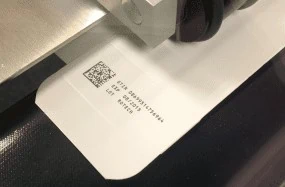Richard Pether, director at Rotech, explains why sometimes it simply makes sense to code offline, even for highly automated manufacturing and packing operations.
-
Rationalise stock:
if you are producing short runs of lots of slightly different variants, you could consider using an offline coder as an ‘on demand’ overprinting system, as this would enable you to reduce stock of pre-printed packaging. Offline systems really come into their own where a large amount of text is required, for example, sowing information on a seed packet or foreign language versions of descriptors and ingredient lists.
-
Your flexible friend:
offline coders can be easily adjusted to accommodate different packaging shapes and sizes. For example, the same friction feed coding system can be adapted to run watch strap sleeves, regular sleeves and cartons. This makes offline coding an inherently flexible and future-proof option.
-
One machine, multiple lines:
a single offline coder can serve multiple lines, whereas online coders are usually designed to be line specific.
-
Wider choice of print technologies:
coding offline gives you the choice of thermal inkjet (TIJ), thermal transfer, laser and hot foil printing methods. Coding online places more limitations on what technology you can use – only non-contact
 technologies (ie TIJ or CIJ) can be deployed once cartons are erected or pouches are filled.
technologies (ie TIJ or CIJ) can be deployed once cartons are erected or pouches are filled. -
Access all areas:
online coders may struggle to code packs that are awkwardly shaped or have hard-to-reach print areas. On an offline system the pack is presented to the coding device in flat form with the print area readily accessible. This allows for consistently accurate code positioning, increasing line efficiency and reducing waste that results from poorly printed packs.
-
Increased throughput:
for companies who are coding packs by hand, an automatic offline coding system will reduce labour costs and speed up production.
-
Products on trial:
an offline coder is the ideal solution for trial products – it allows you to minimise capital outlay whilst ensuring new products are coded according to retailer and regulatory requirements, without impacting on other production.
-
Adapting to seasonal variations:
getting more operators on the job might seem like the easiest way of increasing capacity during seasonal peaks. But in actual fact, purchasing an offline coder to cope with increased production and seasonal lines is usually more cost effective, owing to the speed, flexibilty and accuracy benefits it brings.
-
A solution for promotional labelling:
with the addition of a label applicator, offline coding systems can carry out labelling and coding in one operation. This dual functionality is very useful when producing ‘meal deal’ packs or running promotions. Take a sandwich wedge pack: applying a code online is fairly straightforward, but applying a label at the same time is not so easy due to the awkward pack orientation.
 10. Consistently clear 2D codes:
10. Consistently clear 2D codes:
In some industries, such as pharmaceutical manufacturing, 2D codes are now the norm, and they have to be printed to an exacting standard. Whilst they can be printed online using a TIJ printer, the necessary accuracy will rarely be achieved without the addition of an extra line element that controls the pack during print and inspection. This can have serious space implications and revalidation issues. In addition, an offline coding system can be integrated with a camera to inspect printed cartons, eliminating delays that could arise from badly printed codes.

